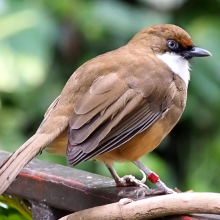Pterorhinus albogularis

Conservation Status:
Least Concern
Range:
Southern edge of the Himalayan mountain range across Asia
Habitat:
Subtropical or tropical mountainous forests
The White-throated Laughingthrush is known for its melodious vocalizations. These birds are highly social and are often found in flocks of 6 to 15 individuals.
In addition to their diet of insects, berries, and seeds, White-throated Laughingthrushes also feed on bugs. Their foraging behavior involves hopping and searching for food on the ground or in low vegetation, using their sharp beaks to extract insects from crevices.
These birds are known for their complex vocalizations, which consist of a combination of whistles, trills, and harsher notes. Their calls are often described as a series of melodious laughs, hence their common name. These vocalizations serve various purposes, including territorial defense, communication within the flock, and mate attraction.
White-throated Laughingthrushes use grass, leaves, and other plant materials to create cup-shaped nests in dense shrubs or trees. The female typically lays a clutch of 2 to 4 eggs, which are incubated by both parents. Both male and female take turns in feeding and caring for the hatchlings once they emerge from the eggs. The fledglings remain with their parents for some time before they become independent.
The White-throated Laughingthrush is considered a species of least concern by the IUCN due to its stable population and wide distribution. While no comprehensive population count has been conducted, it is estimated that the total number of individuals exceeds 10,000.
